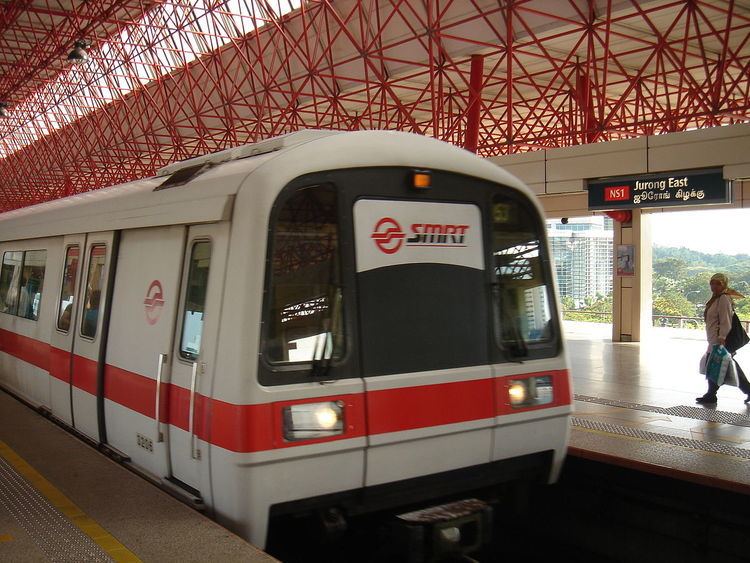Constructed 1993–1994 | ||
 | ||
In service 20 September 1994 - present Number built 114 Vehicles (19 Trainsets) | ||
The Siemens C651, sometimes abbreviated to C651 or SIE C651 trains form a type of rolling stock that can be found on the North South Line and East West Line of the Mass Rapid Transit system in Singapore. A total of 114 cars consisting of 19 train-sets were purchased in 1993 and introduced from 1994 onwards.
Contents
Overview
The C651 trains are the second generation of train cars used on the SMRT network. They were bought mainly to complement the existing C151 trains due to the opening of the Woodlands extension. These trains began revenue service in 1995 as the first train-set rolled out of Singapore plant to increase capacity on 17 July 1994 and delivered to SMRT on 20 September 1994. Unlike its older counterparts, the C651s are painted with a scratch-resistant acrylic finish due to dirt trapping on the aluminum skin of the C151 trains that were difficult to remove.
These train cars are fitted with green-blue tinted Glastroch (Germany) windows glass, and are almost identical to the first generation train cars before its refurbishment, except that its traction produces a louder, lower-pitched noise when accelerating/braking. The run number display on the front of each train is made up of electronic green flip-dot display, as opposed to the manual plastic rollers of the Kawasaki Heavy Industries C151 trains, while the rubber strips between the doors are thicker. The trains have a full white body and a thick red stripe in the middle. Similar to the Kawasaki Heavy Industries C151 trains, the Siemens C651 trains have no visual passenger information systems, but have a built-in audio announcement system until the STARIS was installed and activated around 2010. Currently, these are the only trains that have white exterior bodies.
The C651 trains were originally delivered with a GTO-VVVF propulsion system that was supplied by Siemens. A virtually identical propulsion system would later be used on the Keikyu 2100 series and the JR East E501 series trains.
Operational details
Many experimental programmes have been run on the C651 cars, including the past program.
For the past program, the third and fourth cars, coloured in green were even more radical in the reconfiguration, with all but eight parts of seats, four at each ends of the car removed completely. In its place was standing room with upholstered cushion, in an attempt to provide a degree of comfort to passengers standing in that space. This design proved to be unpopular with the commuters, and it was eventually dropped. The original seats between the 1st and 2nd door, and the 3rd and 4th door on these cars have been replaced. The remaining upholstered seats were reverted to original seats in May 2006. All C151 trains had their seats on the middle part of carriage removed.
For now, some trains of this type were reconfigured to have more standing space in the late 1990s as part of an experimental programme. In particular, the second and fifth cars (the blue cars) were reconfigured to have more standing room on both sides, as 3 seats from some later cars.
More grabpoles were also added. Regular grabpoles in the centre of each car were replaced by grabpoles that branch out into three in the centre first in 2007, followed by triplicated hand grips and grab poles in 2014. Special non slip floorings were also tested.
Refurbishment
Refurbishment contract for these trains have been awarded to Singapore Rail Engineering (SRE). When completed, these upgrades will address train components such as doors and brakes that have been the primary cause of delays owing to train faults. The changes will include re-signalling, refurbishing the propulsion system, air-conditioning system, auxiliary power system, interior saloon with modifying handrails and exterior of the trains. Upgraded trains will also have sensors that carries vital information on the train’s state of health for improved operation and maintenance of the train set.
Refurbishment works has begun since early 2016, beginning with train set 217/218. It will also include STARIS version 2.0, of which it will consist of the dynamic route map displays. The first refurbished train set is expected to undergo dynamic tests and commence revenue service in mid 2017.As of late August 2016, 2 prototype train cars have been built by SRE for evaluation, signalling that this MLR project is unaffected by termination of the End-of Life Refurbishments for the 66 C151 train sets.
Train Formation
The configuration of a C651 in revenue service is DT-M1-M2-M2-M1-DT
The car numbers of the trains range from x201 to x238, where x depends on the carriage type. Individual cars are assigned a 4 digit serial number by the rail operator SMRT Trains. A complete six-car trainset consists of an identical twin set of one driving trailer(DT) and two motor cars(M1 & M2) permanently coupled together. For example, set 221/222 consists of carriages 3221, 1222, 2221, 2222, 1222 and 3222.
